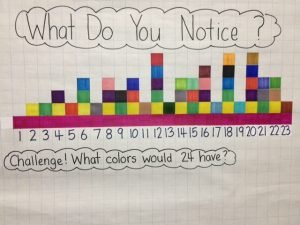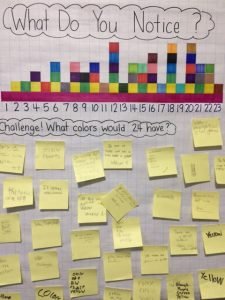What Do You Notice? Number Theory

Skills
K-2: counting, skip counting, patterns, even/odd numbers
3-5: even/odd numbers, patterns, multiples, factors, multiplication, common multiples, prime/composite numbers
Background Information
When students learn to skip count* they are reciting the multiples of the number they started with. It’s a great early introduction to multiplication. This poster is a horizontal representation of some of the multiples for numbers 1 – 23 which are represented by different colors. For example, multiples of 1 are magenta; multiples of 2 are yellow; 3 are green, etc.
When students learn to skip count* they are reciting the multiples of the number they started with. It’s a great early introduction to multiplication. This poster is a horizontal representation of some of the multiples for numbers 1 – 23 which are represented by different colors. For example, multiples of 1 are magenta; multiples of 2 are yellow; 3 are green, etc.
Factors are the numbers multiplied together to arrive at another number. For example, 2 and 3 are the factors that, when multiplied, result in the product 6. This poster shows the factors of each number vertically. The factors of 6 are: 1 (magenta), 2 (yellow), 3, (green), and 6 (blue).
1 x 6 = 6 and 2 x 3 = 6
This visual representation also does a nice job of calling out the prime and composite numbers. A prime number has exactly two factors – one and itself. The numbers with more than two factors are called composite numbers. The number 1 is neither a prime or composite number as is represented by only one color.
Younger students can count the colors of a given number or compare which color stacks are the same height. Or they can count how many of each color or even count all the squares!
The Challenge! question can be a fun one as students look for patterns in the colors/numbers. The number 24 would have all the same colors as the number 12 plus an additional color for the number itself.
*It’s possible to skip count by starting with a random number and skip counting by a different number. For example, start with 5 and skip count by 2s. However, skip counting for this activity is counting by a given number other than 1.
Here’s what it looked like at the event:
